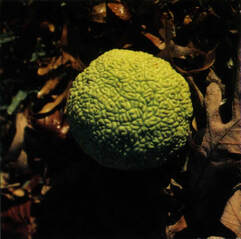 A bowdark tree and its fruit.
A bowdark tree and its fruit. Bowdarks are short, scraggly trees, easily overlooked in the landscape. The rather nondescript leaves--ovate to lance-shaped, three to five inches long and two to three inches wide-are borne on stout, thorny twigs. Like other members of the mulberry family (including true mulberries, figs, and breadfruit), bowdarks produce a juicy latex and a compound fruit, which is quite large. These fruits, brain-like in texture and grapefruit-sized, mature in late autumn, crashing to the ground with loud chumps.
While the scientific name has an interesting history, the common names of this plant cell its story best. The name "bowdark" or "bowdock" is butchered French for bois d'arc, wood-of-the-bow. The French voyageurs, paddling through Arkansas and Missouri to trap and trade, named it such to commemorate its near-legendary qualities in making archery bows and tomahawks. Bowdark wood is hard, strong, resilient, and inert to changes in humidity. Initially yellow with red flecks, the heartwood darkens and "sweetens" with age, like that of a superior violin.
Another common name, Osage orange, refers co the American Indian tribe most associated with the plant. Since the Osages had a ready supply of bowdark wood, their tribal lands were central to its trading, both as raw material and as finished product. Meriwether Lewis, traveling up the Missouri River through Osage country on his way west, shipped cuttings of these trees to his mentor, Thomas Jefferson, and the results are still growing today.
Since their discovery by American pioneers following the Lewis and Clark expedition, bowdark range has been greatly expanded, and they are now known from southern Canada to Colorado, the Eastern United States, the West Coast, Europe, and Australia. (Found throughout Alabama, they are most likely encountered in the Black Belt, adapting easily to the prairie soils there.) Widely planted from 1850- 1875, they were touted as the perfect hedge planes, their twisted forms and thorny branches producing a hedge that met the age-old demands of "horse-high, bull-strong, and pig-tight." While most of these hedges have been replaced by barbed wire (destroying wildlife habitat in the process), the name "hedge ball" remains today.
Finally, the common name "horse apple" is sometimes applied. Horses readily eat the fruits, the remains dripping from their muzzles as a green, frothy mess. Wild creatures, such as deer, opossums, and squirrels, also consume them, especially the seeds inside. (Fox squirrels are the cleverest consumers, hauling the heavy fruits to a high branch, then dropping them to smash open on the ground.) While inedible by humans--in fact, the latex causes dermatitis in some folks-they are not without their uses. The fruits are placed in basements, closets, and cupboards to drive away cockroaches and waterbugs.
So what's in a name? A rose, we are told, while sporting a different moniker, would smell as sweet as before. But would a bowdark still make good bows?
 RSS Feed
RSS Feed